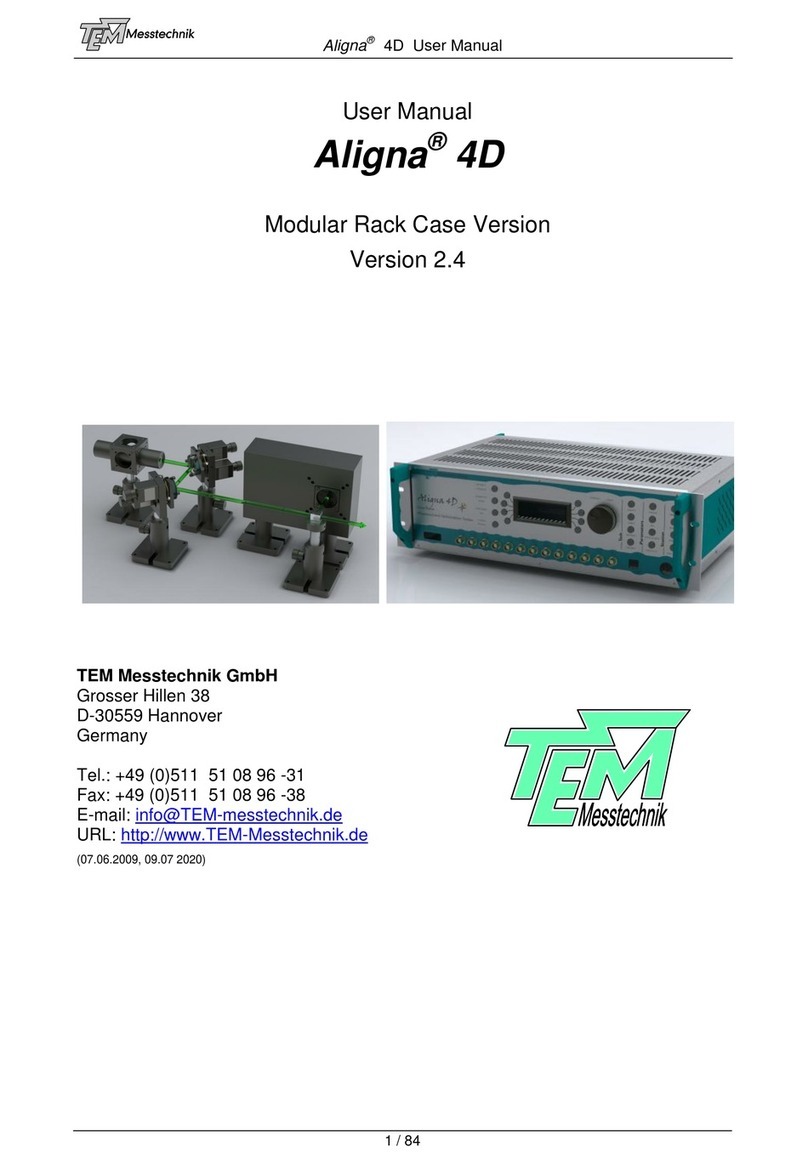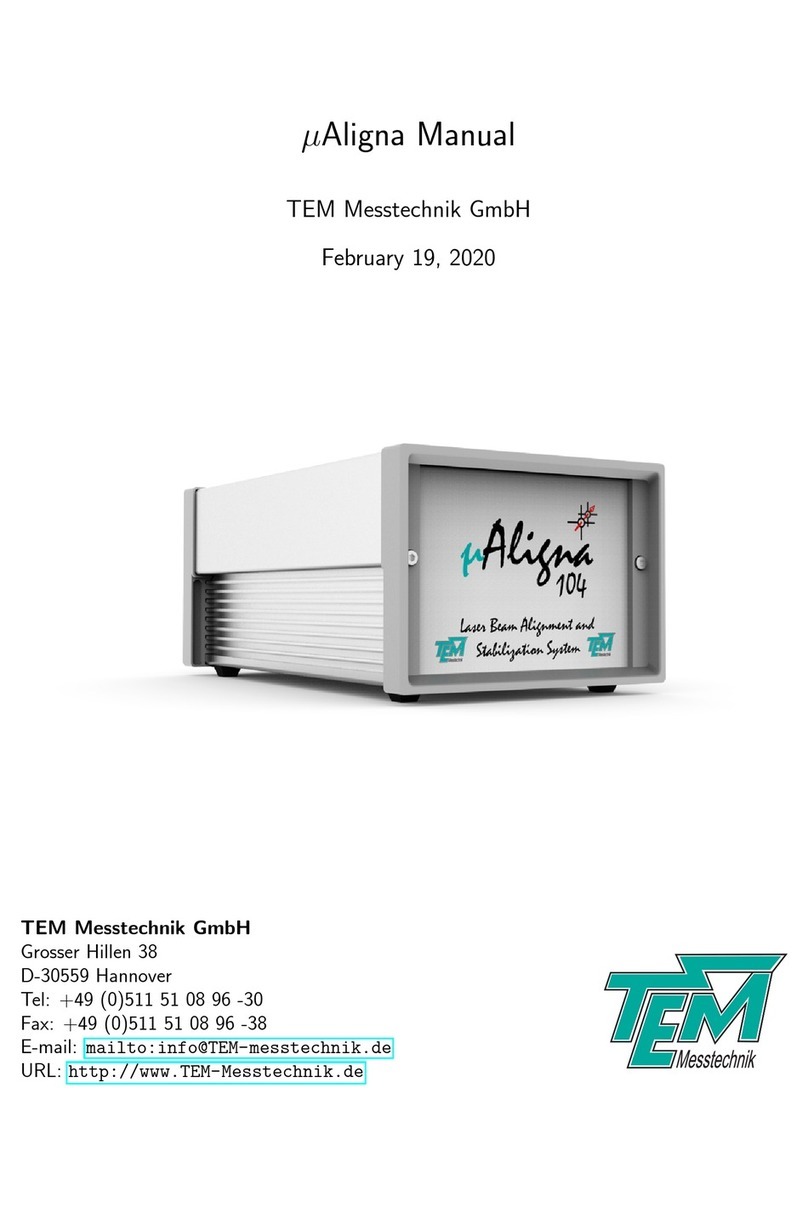TEM PhaseLock User manual


PhaseLockManual
Contents
1 Product description 5
1.1 General......................................... 5
1.2 Functionalcomponents ................................ 5
2 Safety Instructions 7
3 Scope of delivery 9
3.1 Mandatorycomponents ................................ 9
3.2 Components for standard (MCPC) configuration . . . . . . . . . . . . . . . . . . . 9
3.3 Optionalparts ..................................... 9
3.4 Alternativeparts.................................... 9
4 Brief description of the control elements 10
4.1 Frontpanelelements.................................. 10
4.2 Rearpanelelements .................................. 13
4.3 Touchscreen...................................... 15
4.3.1 Displaysettings ................................ 15
5 Installation 16
5.1 Placement ....................................... 16
5.2 MainsConnection ................................... 16
5.3 Alternative DC power supply . . . . . . . . . . . . . . . . . . . . . . . . . . . . . . 16
5.4 ConnectiontoPC ................................... 16
6 Getting started 17
6.1 Overview........................................ 17
6.2 Using the PC visualization software “Kangoo” . . . . . . . . . . . . . . . . . . . . 17
6.3 Inputsignalconnections................................ 18
6.4 Output signal connections . . . . . . . . . . . . . . . . . . . . . . . . . . . . . . . 19
6.5 Outputsignalrange .................................. 21
6.6 Switchthedeviceon.................................. 22
6.7 InputSignalMonitor.................................. 22
6.8 InputSignalAdjustment................................ 24
6.9 Outputsignalcheck .................................. 25
6.9.1 Check and adjustment of the actuator at output B (HV out 2) . . . . . . . 25
6.9.2 Check of the actuator at output A (HV out 1) . . . . . . . . . . . . . . . . 26
6.10 Taking the PID regulator A into operation . . . . . . . . . . . . . . . . . . . . . . 27
6.11 Optimizing the PID regulator . . . . . . . . . . . . . . . . . . . . . . . . . . . . . 29
6.12 Taking the PID regulator B into operation . . . . . . . . . . . . . . . . . . . . . . 30
6.13 Loss of input signal and hold mode . . . . . . . . . . . . . . . . . . . . . . . . . . 32
6.14Automaticsearchmode ................................ 32
7 Operation 35
CONTENTS 3 / 60

PhaseLockManual
8 Detailed description 37
8.1 FrequencyMixer.................................... 37
8.2 Signalmonitor ..................................... 38
8.2.1 Analog monitor signals . . . . . . . . . . . . . . . . . . . . . . . . . . . . . 38
8.2.2 TTLoutput .................................. 39
9 Software Installation 39
9.1 Installation of the Kangoo Software . . . . . . . . . . . . . . . . . . . . . . . . . . 39
9.2 Installation of LabView Drivers . . . . . . . . . . . . . . . . . . . . . . . . . . . . 41
9.3 InstallingtheUSBDrivers............................... 41
9.4 UpgradingtheFirmware................................ 42
10 Communication interface 43
10.1Communicationsyntax................................. 43
10.2Variables........................................ 45
10.3Inputsettings ..................................... 45
10.4 Quadrature signal analysis . . . . . . . . . . . . . . . . . . . . . . . . . . . . . . . 45
10.5Monitorsettings .................................... 46
10.6 Regulator (servo loop) settings . . . . . . . . . . . . . . . . . . . . . . . . . . . . 47
10.7Outputsettings .................................... 48
10.8 ”Search for signal” settings . . . . . . . . . . . . . . . . . . . . . . . . . . . . . . 48
10.9Stepresponsesettings................................. 48
10.10Scansettings...................................... 49
10.11Triggersettings .................................... 50
10.12Motordriversettings.................................. 51
10.13Ditherlocksettings .................................. 52
10.14Measurementsettings ................................. 53
10.15Systeminformation .................................. 53
11 Electrical Specifications 54
11.1TechnicalData..................................... 54
11.2MainsPowerCable................................... 55
11.3HD-15Connector ................................... 55
12 Delivery Content 56
13 Customer Service 56
4 / 60 CONTENTS

PhaseLockManual
1 Product description
1.1 General
PhaseLock is a general electronic device for the set-up of a phase-locked loop (PLL). It synchronizes
the pulse train of a laser with an electronic reference clock or with another laser (see figure 1).
PhaseLock comprises a phase comparator unit for two periodic RF (radio frequency) input signals
and two PID controllers as well as a logic section that eases the locking and re-locking. High voltage
amplifiers for PZT actuators and a micro stepping motor driver are available as add-ons.
PhaseLock well applies for:
Stabilization of the repetition frequency and pulse timing of pulsed lasers
Control of the pulse envelope phase (carrier offset frequency) of femtosecond lasers
Stabilization of frequency or phase of electronic oscillators
Phase locking of the optical frequency of continuous-wave (cw) lasers was reportedly accomplished
successfully.
1.2 Functional components
PhaseLock combines all components required or beneficial for this purpose in a user-friendly compact
device:
multi cycle phase comparator
input section for signal conditioning
independent PID regulators, adapted especially to resonant systems like piezo-driven optical
components
output amplifier, user-selectable as high-voltage amplifier for piezo actuators, or as low-voltage
amplifier generating a control signal for external amplifier sections
logic section for automatic recognition of successful locking
Figure 1: PhaseLock principle of operation
1 PRODUCT DESCRIPTION 5 / 60
Table of contents
Other TEM Industrial Equipment manuals





















